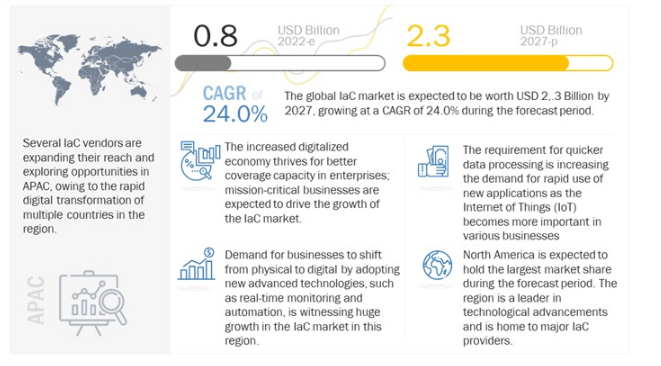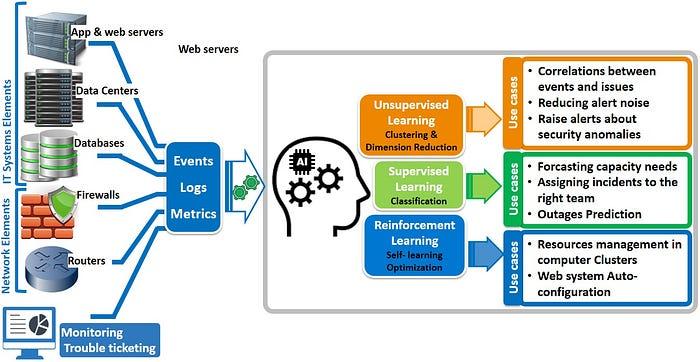Automation in Infrastructure Management: Trends and Innovations

Audio : Listen to This Blog.
Infrastructure management automation transforms building, deploying, and maintaining our IT environments. With the rapid evolution of cloud computing and the increasing complexity of modern architectures, automating infrastructure has become essential to defining standard operating environments for servers and workstations and managing infrastructure efficiently. Adopting automation can achieve higher efficiency, scalability, reliability, and cost savings. In this blog, I’ll delve into the key trends and innovations in this field, offering insights into how automation reshapes infrastructure management.
The Rise of Infrastructure as Code (IaC) and Infrastructure Automation

Source: MarketsandMarkets
One of the foundational elements of automation in infrastructure management is Infrastructure as Code (IaC). Configuration management is crucial in IaC, as it defines infrastructure states, ensures consistent configurations, and enforces desired states across servers and network devices. IaC enables us to define and provision infrastructure using version-controlled and reused code. This approach ensures consistency across different environments and speeds up deployment times. We can apply software development best practices such as code reviews, automated testing, and continuous integration to our infrastructure changes by treating infrastructure configurations as code.
This minimizes configuration drift and enhances team collaboration as infrastructure definitions become part of the shared codebase. IaC tools like Terraform and AWS CloudFormation also offer robust support for managing complex, multi-cloud environments, providing a unified way to handle resources across various cloud providers. By adopting IaC, organizations can achieve greater agility, reduce manual errors, and create more predictable and repeatable infrastructure deployments.
Evolution to IaC 2.0 and Infrastructure Provisioning
The concept of IaC is evolving, with new tools offering higher-level abstractions and more flexibility. Infrastructure automation solutions play a crucial role in this evolution by enabling automation across diverse IT environments, including multi-OS, multi-cloud, on-premises, hybrid, and legacy architectures. Tools like Pulumi and AWS Cloud Development Kit (CDK) allow us to write infrastructure code using general-purpose programming languages like TypeScript, Python, and Go. This modern approach to IaC, often called IaC 2.0, enables developers to use familiar programming constructs and create more sophisticated and maintainable infrastructure configurations.
AI and Machine Learning in Infrastructure Management

Source: Medium
Artificial intelligence (AI) and machine learning (ML) are making significant inroads into infrastructure management. Infrastructure monitoring plays a crucial role in these applications by providing the necessary data for analysis and decision-making. These technologies can analyze vast amounts of data to automate decision-making processes and predict future needs.
Predictive Scaling
With AI and ML, we can implement predictive scaling, where the system anticipates resource requirements based on historical data and usage patterns. AWS SageMaker, for example, allows us to build and train ML models that can predict traffic spikes and scale resources accordingly. This proactive approach ensures optimal performance and cost-efficiency.
Anomaly Detection
Another critical application of AI and ML is anomaly detection. By continuously monitoring infrastructure metrics, AI can identify unusual patterns or behaviors that may indicate potential issues or security threats. AWS offers various AI services to automate anomaly detection, helping us maintain a secure and reliable infrastructure.
Serverless Computing: Simplifying Infrastructure Management

Serverless computing represents a paradigm shift in how we manage infrastructure. Infrastructure provisioning, which involves creating and managing infrastructure resources, is automated in serverless computing. With serverless, we no longer need to provision or manage servers. Instead, we can focus on writing code that delivers business value while the cloud provider handles the underlying infrastructure.
AWS Lambda: The Frontier of Serverless
AWS Lambda is a leading service in the serverless ecosystem. It allows us to run code responding to events without worrying about server management. This not only simplifies the development process but also enhances scalability and cost-efficiency. Lambda functions automatically scale based on the number of incoming requests, ensuring we only pay for the compute time we consume.
Integration with Other AWS Services
Serverless computing integrates seamlessly with other AWS services, enabling us to build highly modular and event-driven applications. For example, we can trigger Lambda functions using Amazon S3 events, DynamoDB streams, or API Gateway requests. This tight integration streamlines the development process and reduces operational overhead.
Auto-Scaling Web Applications
One of the most common use cases for automation in infrastructure management is auto-scaling web applications. Auto-scaling involves managing various infrastructure components, such as servers and network devices, to ensure consistent configurations and optimal performance. By utilizing services like elastic load balancing (ELB) and auto-scaling, we can dynamically adjust the number of instances based on real-time traffic patterns.
Elastic Load Balancing and Auto Scaling
Elastic Load Balancing distributes incoming application traffic across multiple targets, enhancing fault tolerance and availability. Combined with Auto Scaling, we can set predefined scaling policies that trigger adding or removing instances based on metrics such as CPU utilization or request rate. This dynamic adjustment ensures consistent application performance and optimizes resource utilization.
Disaster Recovery: Automation for Resilience

Disaster recovery is critical to infrastructure management, and automation is pivotal in ensuring resilience. Infrastructure resources, including virtual machines, software, and configuration, play a crucial role in disaster recovery by enabling scalability, reproducibility, and iterative development. In an era where digital operations are the backbone of business continuity, downtime can result in significant financial losses, data breaches, and reputational damage.
Therefore, having a robust disaster recovery strategy is non-negotiable. Automated disaster recovery processes enable organizations to respond swiftly to disruptions, ensuring that critical systems and data are protected and quickly restored. This automation includes regularly scheduled backups and automated failover mechanisms that activate during outages or system failures.
By automating backup and failover processes, we can minimize downtime and protect our data with precision and reliability. Automated backups ensure that all essential data is consistently saved at predetermined intervals, providing up-to-date snapshots that can be swiftly restored.
AWS CloudFormation and AWS Backup
AWS CloudFormation allows us to define and deploy infrastructure templates that can be quickly replicated in different regions. During a disaster, the failover process can be automated to shift workloads to backup instances seamlessly. AWS Backup simplifies and centralizes backup management, ensuring that data is regularly saved and easily recoverable. Automating these processes enhances our ability to respond swiftly and reliably to disruptions.
DevOps and Continuous Delivery: Automation for Agility

DevOps practices rely heavily on automation to streamline development, testing, and deployment processes. IT teams play a crucial role in these practices by focusing on strategic initiatives, driving innovation, and delivering greater value to the business. Automating these tasks can reduce manual effort, eliminate bottlenecks, and accelerate the overall software development lifecycle. Continuous integration and continuous delivery (CI/CD) pipelines are essential components of a robust DevOps strategy, enabling teams to integrate code changes frequently and deploy them rapidly to production environments.
These pipelines ensure that every code change is automatically tested and validated, reducing the risk of errors and enhancing the reliability of software releases. Tools like AWS CodePipeline and Jenkins facilitate creating and managing CI/CD workflows, allowing for seamless integration with other development tools and services.
AWS CodePipeline and AWS CodeDeploy
AWS CodePipeline automates the end-to-end release process, orchestrating the building, testing, and deploying of code changes. This ensures that new features and updates are consistently and reliably deployed. AWS CodeDeploy automates application deployments to various compute services, supporting blue/green and rolling updates. Integrating these tools into DevOps workflows can accelerate software delivery and enhance team collaboration.
Monitoring and Observability: Automated Insights and Monitoring Tools
Effective infrastructure management requires comprehensive monitoring and observability. A monitoring tool is crucial in this process, providing the necessary functionality to track system health and performance metrics. Automation can enhance our ability to monitor system health and gain insights into performance metrics. By leveraging automated monitoring tools and services like AWS CloudWatch and Prometheus, we can set up real-time alerts and dashboards that provide visibility into key performance indicators across our infrastructure.
These automated systems can detect anomalies, predict potential issues, and trigger predefined responses to mitigate risks before they impact users. Furthermore, integrating monitoring with AI and machine learning capabilities allows for advanced analytics and trend analysis, enabling proactive infrastructure management and continuous improvement.
AWS CloudWatch
AWS CloudWatch is a powerful monitoring and observability service that provides real-time insights into resource utilization, application performance, and operational health. Setting up CloudWatch Alarms allows us to automate alerts based on predefined thresholds, enabling prompt responses to potential issues. CloudWatch Logs and Metrics also will allow us to collect and analyze log data, providing deeper visibility into our infrastructure.
AWS X-Ray
For distributed applications, AWS X-Ray offers advanced tracing capabilities. X-Ray allows us to trace requests as they travel through the various services in our architecture, identifying performance bottlenecks and optimizing overall performance. Automated tracing and analysis help us maintain a high level of observability and ensure the reliability of our applications.
Security Automation: Safeguarding Infrastructure
Security is paramount in infrastructure management, and automation plays a crucial role in enforcing security policies and protecting against threats. Infrastructure processes, such as provisioning and handling, are automated to eliminate manual tasks and enhance efficiency. Automated security tools can continuously monitor our infrastructure for vulnerabilities, misconfigurations, and compliance issues, identifying and addressing potential risks promptly.
Additionally, automating security policy enforcement through mechanisms such as Infrastructure as Code (IaC) ensures that security best practices are consistently applied across all deployments, reducing the likelihood of human error and enhancing overall system integrity.
AWS Identity and Access Management (IAM)
AWS Identity and Access Management (IAM) allows us to automate the management of user permissions and access controls. By defining and enforcing IAM policies, we can ensure that users have the appropriate level of access to resources. Automation tools can continuously monitor and audit IAM configurations, detecting and addressing potential vulnerabilities.
AWS Security Hub
AWS Security Hub provides a centralized view of security findings across our AWS environment. It aggregates and prioritizes security alerts from various AWS services, enabling us to automate responses to security incidents. Integrating with AWS Lambda allows us to create automated remediation workflows that address security issues in real-time.
Hybrid Cloud Management: Bridging On-Premises and Cloud
As organizations increasingly adopt hybrid cloud strategies, managing infrastructure across on-premises and cloud environments becomes more complex. Lifecycle management plays a crucial role in hybrid cloud management by overseeing the entire lifecycle of infrastructure resources, including deployment, configuration, maintenance, security, and updating of firmware, driver, and OS versions for security and stability purposes through intelligent automation and orchestration.
These tools enable consistent policy enforcement, resource provisioning, and monitoring across diverse infrastructures, simplifying management tasks. Moreover, automation facilitates workload migration and scalability, allowing organizations to optimize resource utilization and achieve greater flexibility in their hybrid cloud strategies.
AWS Outposts
AWS Outposts extends AWS infrastructure and services to on-premises environments. With Outposts, we can automate the deployment and management of AWS services locally, ensuring consistency with our cloud-based infrastructure. This hybrid approach enables us to leverage the benefits of AWS automation while meeting regulatory and latency requirements.
AWS Systems Manager
AWS Systems Manager provides a unified interface for managing resources across on-premises and cloud environments. It includes Run Command, Patch Manager, and State Manager tools to automate routine management tasks. The Systems Manager simplifies hybrid infrastructure management by centralizing these functions and ensuring best practices are followed.
Container Orchestration: Automating Microservices
Containers and microservices architectures offer scalability and flexibility but also introduce management challenges. Virtual machines are crucial in container orchestration by providing the necessary infrastructure for automation, resource provisioning, and configuration management. Automation tools can streamline container orchestration and enhance the efficiency of microservices deployments.
Amazon Elastic Kubernetes Service (EKS)
Amazon Elastic Kubernetes Service (EKS) is a fully managed Kubernetes service that simplifies the deployment and management of containerized applications. EKS automates tasks such as cluster provisioning, scaling, and updates, allowing us to focus on building and running applications. Integration with other AWS services, such as IAM and CloudWatch, enhances the security and observability of our Kubernetes clusters.
AWS Fargate
AWS Fargate is a serverless compute engine for containers that eliminates the need to manage underlying infrastructure. With Fargate, we can run containers without provisioning or managing servers, simplifying the deployment process. Fargate automatically scales resources based on demand, ensuring optimal performance and cost-efficiency. This approach allows us to reap the benefits of containerization without the operational overhead.
Edge Computing: Automation at the Edge
Edge computing is gaining traction as organizations seek to process data closer to the source. Operations teams are crucial in managing edge computing infrastructure, ensuring seamless collaboration and efficient operations. Automation is essential for managing edge infrastructure efficiently. By automating deployment and updates of edge devices, businesses can ensure consistent performance and reduce downtime. Additionally, automated monitoring and maintenance allow for real-time insights and quick issue resolution, enhancing the reliability and scalability of edge networks.
AWS IoT Greengrass
AWS IoT Greengrass extends AWS capabilities to edge devices, enabling local data processing and execution of Lambda functions. Greengrass automates deploying and managing software updates and configurations across numerous edge devices. This automation ensures that edge infrastructure remains up-to-date and secure, even in remote or disconnected environments.
AWS Wavelength
AWS Wavelength brings AWS services to the edge of the 5G network, delivering ultra-low latency applications. Automation tools integrated with Wavelength can manage the deployment and scaling of edge applications, ensuring seamless connectivity and performance. This innovation is particularly valuable for latency-sensitive applications such as autonomous vehicles and industrial automation.
Conclusion: Embracing Automation for Future-Ready Infrastructure
Automation in infrastructure management is no longer a luxury but a necessity in today’s fast-paced and complex digital landscape. Manual management methods are not sustainable with the ever-increasing complexity of cloud environments and the constant demand for faster, more reliable service delivery. By embracing automation, we can achieve unprecedented efficiency, scalability, reliability, and security, allowing our organizations to stay competitive and agile.
